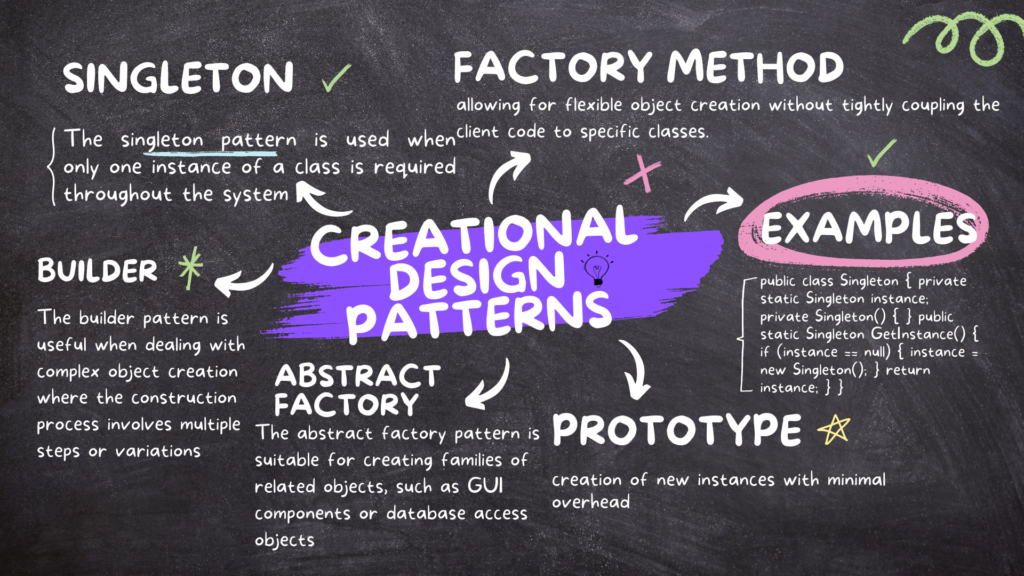Creational design patterns are a crucial part of software development, providing solutions to create objects in a flexible and efficient manner. These patterns address the various challenges faced during object creation, ensuring that the process is scalable, maintainable, and optimized. In this article, we will delve into the world of creational design patterns, exploring their types, usage, benefits, and examples.

Table of Contents
What are Creational Design Patterns?
Creational design patterns are a set of design patterns that deal with object creation mechanisms, trying to create objects in a manner suitable to the situation. They help in making a system independent of how its objects are created, composed, and represented, providing flexibility and reusability in object creation.
Types of Creational Design Patterns
- Singleton Pattern: Ensures that a class has only one instance and provides a global point of access to that instance.
- Builder Pattern: Separates the construction of a complex object from its representation, allowing the same construction process to create different representations.
- Factory Method Pattern: Defines an interface for creating an object but lets subclasses alter the type of objects that will be created.
- Abstract Factory Pattern: Provides an interface for creating families of related or dependent objects without specifying their concrete classes.
- Prototype Pattern: Creates new objects by copying an existing object, known as the prototype, rather than creating new instances from scratch.
Usage and Benefits
1. Singleton Pattern
The singleton pattern is used when only one instance of a class is required throughout the system. For example, a configuration manager or a logging system often uses the singleton pattern to ensure a single point of access.
2. Builder Pattern
The builder pattern is useful when dealing with complex object creation where the construction process involves multiple steps or variations. It promotes code readability and allows for the creation of different object representations using the same construction process.
3. Factory Method Pattern
The factory method pattern is employed when a class cannot anticipate the type of objects it needs to create. It provides a way to delegate the object creation to subclasses, allowing for flexible object creation without tightly coupling the client code to specific classes.
4. Abstract Factory Pattern
The abstract factory pattern is suitable for creating families of related objects, such as GUI components or database access objects. It enables the creation of objects with a consistent interface while hiding the implementation details, promoting encapsulation and flexibility.
5. Prototype Pattern
The prototype pattern is used to create new objects by cloning existing ones, which is particularly useful when object creation is costly or complex. It allows for the creation of new instances with minimal overhead, improving performance and resource utilization.
Examples of Creational Design Patterns
Let’s illustrate the usage of creational design patterns with some examples:
1. Singleton Pattern Example
public class Singleton
{
private static Singleton instance;
private Singleton() { }
public static Singleton GetInstance()
{
if (instance == null)
{
instance = new Singleton();
}
return instance;
}
}
2. Builder Pattern Example
public class Product
{
public string Name { get; set; }
public decimal Price { get; set; }
// Other properties
public class Builder
{
private Product product = new Product();
public Builder WithName(string name)
{
product.Name = name;
return this;
}
public Builder WithPrice(decimal price)
{
product.Price = price;
return this;
}
// Other builder methods
public Product Build()
{
return product;
}
}
}
3. Factory Method Pattern Example
public abstract class Vehicle
{
public abstract void Drive();
}
public class Car : Vehicle
{
public override void Drive()
{
Console.WriteLine("Driving a car");
}
}
public class Bike : Vehicle
{
public override void Drive()
{
Console.WriteLine("Riding a bike");
}
}
public abstract class VehicleFactory
{
public abstract Vehicle CreateVehicle();
}
public class CarFactory : VehicleFactory
{
public override Vehicle CreateVehicle()
{
return new Car();
}
}
public class BikeFactory : VehicleFactory
{
public override Vehicle CreateVehicle()
{
return new Bike();
}
}
4. Abstract Factory Pattern Example
public interface IButton
{
void Render();
}
public class WindowsButton : IButton
{
public void Render()
{
Console.WriteLine("Rendering a Windows button");
}
}
public class MacOSButton : IButton
{
public void Render()
{
Console.WriteLine("Rendering a MacOS button");
}
}
public interface IGUIFactory
{
IButton CreateButton();
}
public class WindowsGUIFactory : IGUIFactory
{
public IButton CreateButton()
{
return new WindowsButton();
}
}
public class MacOSGUIFactory : IGUIFactory
{
public IButton CreateButton()
{
return new MacOSButton();
}
}
5. Prototype Pattern Example
public class Shape : ICloneable
{
public string Type { get; set; }
public object Clone()
{
return MemberwiseClone();
}
}
public class Rectangle : Shape
{
public Rectangle()
{
Type = "Rectangle";
}
}
public class Circle : Shape
{
public Circle()
{
Type = "Circle";
}
}
Conclusion
Creational design patterns play an important role in software development by providing flexible and efficient object creation mechanisms. By understanding and applying these patterns appropriately, developers can improve code quality, maintainability, and scalability in their projects.
References
For more information and detailed references on the topics discussed in this article, please refer to the following link: